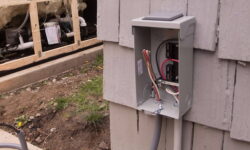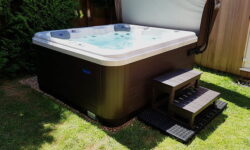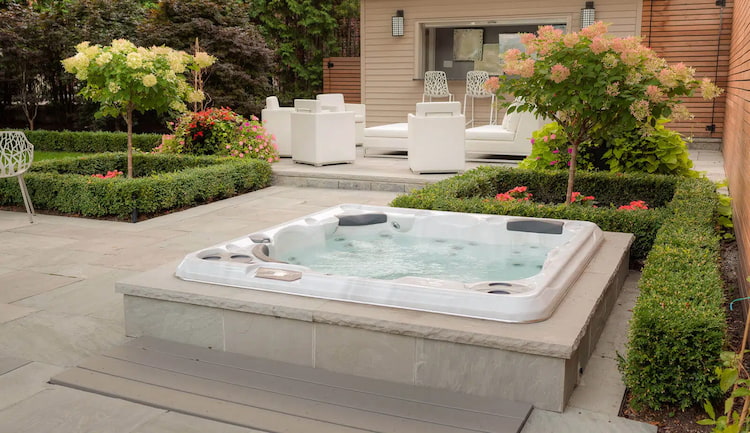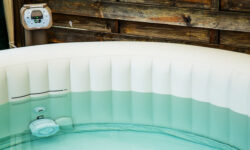Ever thought about sprucing up your backyard pool by adding a hot tub? You’re in the right place!
You can add a hot tub to an existing pool. This is often done as a part of a pool renovation or remodel. The process involves plumbing integration, electrical work, and construction of the hot tub itself. However, this should be done by professionals to ensure safety and proper functionality.
This article will guide you through the process, illustrating the structural feasibility, cost implications, and pros and cons. We’ll also provide a step-by-step plan to ensure a smooth execution.

Quick Navigation
Understanding the Basics of Pool-Hot Tub Combo
You need to grasp the fundamentals of a pool-hot tub combo before deciding to incorporate a hot tub into your existing pool.
This setup is typically designed so that the hot tub and pool share a common wall, with the hot tub elevated above the pool level. The main advantage is convenience, as it allows for an easy transition from hot to cold.
You should consider the heating system, which often uses the same heater for both the pool and hot tub. However, this could lead to temperature imbalances if not properly managed. The water circulation system is another critical element. It’s designed to allow water to flow from the hot tub into the pool, helping to balance the water levels.
Then there is the matter of installation. It isn’t as simple as digging a hole and adding a hot tub. It requires careful planning and expert execution. The structural integrity of the existing pool must be preserved while accommodating the hot tub.
Evaluating the Structural Feasibility
Before diving into the project, it’s crucial that you assess the structural feasibility of adding a hot tub to your existing pool.
Structural feasibility refers to the ability of your pool’s existing structure to withstand the additional weight, pressure, and water volume that the hot tub would bring. Remember, a hot tub isn’t a simple add-on—it’s a significant addition that will put new demands on your pool’s structure.
To help you understand, consider the following table:
| Factors | Significance |
|---|---|
| Weight | Hot tubs are heavy, even when empty. The weight increases when filled with water and people. Your pool’s structure must be able to support this. |
| Pressure | The water in a hot tub exerts pressure on its walls and floor. If your pool cannot handle this, it could lead to structural damage. |
| Water Volume | Adding a hot tub increases the total volume of water. This can affect the pool’s plumbing system and filtration capacity. |
Consult with a structural engineer or a pool professional to accurately evaluate the feasibility. They’ll consider these factors, among others, to determine if your pool can accommodate a hot tub safely and efficiently.
Cost Implications of Adding a Hot Tub
Adding a hot tub to your existing pool isn’t just a structural consideration, it’s also a significant financial investment.
The cost will depend on several factors, including the type of hot tub, its size, and the specific installation requirements. You’re looking at a range of $2,000 to over $15,000 for the hot tub itself.
Installation costs are also a crucial aspect to consider. These can include excavation, electrical work, and plumbing, which can add an additional $1,000 to $5,000 to your budget. You also need to factor in the ongoing costs of running and maintaining a hot tub, such as energy consumption, water treatment products, and regular servicing.
Moreover, if you want to integrate the hot tub into your pool’s existing heating and filtration systems, you may face higher initial costs for these complex adjustments.
Project Planning and Execution Steps
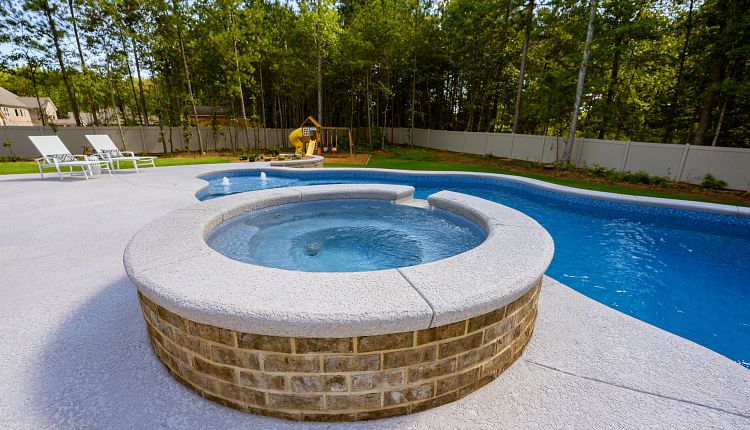
The first step in adding a hot tub to your existing pool is to carefully plan your project and understand the steps involved in its execution.
This isn’t a task you’ll want to rush into. A well-executed plan will ensure your project runs smoothly and ends successfully.
Here are the key steps you’ll need to follow:
- Assess feasibility: evaluate your pool’s structure and location to determine if it can accommodate a hot tub. You may need to consult a professional for this.
- Design and planning: decide on the hot tub’s size, style, and placement. Sketch it out, considering factors like sunlight, privacy, and access to power.
- Budgeting: calculate the total cost, including the hot tub, installation, and any necessary modifications to your pool or backyard.
- Hire professionals: unless you’re an expert, it’s best to hire professionals for installation. They’ll ensure the job is done correctly and safely.
- Permits and inspections: check with local authorities for any required permits or inspections. You don’t want to face any legal issues after your hot tub is installed.
Pros and Cons of Pool-Hot Tub Integration
Once you’ve navigated the planning and execution stages, it’s essential to weigh the pros and cons of integrating a hot tub into your existing pool.
This strategic decision has its merits and demerits that are crucial to consider before making a final investment.
| Pros | Cons |
|---|---|
| Enhanced Aesthetics | Additional Maintenance |
| Increased Property Value | Higher Energy Costs |
| Therapeutic Benefits | Space Requirements |
| Year-Round Usability | Safety Concerns |
The integration’s obvious aesthetic appeal can significantly boost your property’s value.
The hot tub’s therapeutic benefits like stress relief and muscle relaxation can’t be overlooked. Additionally, it offers year-round usability, providing a warm retreat during colder months.
However, this integration isn’t without its downsides. The increased energy costs due to heating the hot tub are a significant concern. Maintenance responsibilities also rise with the added complexity of managing two water systems.
The space requirements can be hefty. You’ll need an ample area for a seamless integration. Lastly, safety becomes more complex with a hot tub, especially if there are children or elderly family members.
Frequently Asked Questions
Maintaining a pool-hot tub combo involves frequently checking water chemistry, cleaning filters, and ensuring pumps work properly. You’ll need to balance pH levels and regularly sanitize both the pool and hot tub.
Absolutely, you can install a hot tub on your own. However, it’s recommended you hire a professional. They’ll ensure correct installation, electrical wiring, and adherence to safety standards, saving you potential headaches.
Yes, when installing a hot tub, you’re required to adhere to specific safety regulations. It’s crucial you ensure proper electrical wiring, adequate water supply, and appropriate chemical levels to maintain safety and hygiene.
Typically, you’re looking at roughly one to three weeks to install a hot tub into an existing setup. It’ll vary based on complexity, weather, and the contractor’s schedule. Always plan for potential delays.
Yes, adding a hot tub will impact your pool’s existing filtration system. It’ll require more filtration and possibly an upgrade to handle the increased water volume and maintain water cleanliness and temperature.
Conclusion
In conclusion, adding a hot tub to your existing pool is feasible, but it requires careful consideration. You need to evaluate the structural soundness of your pool, understand the potential cost, and plan the project diligently.
While this integration offers numerous benefits like enhanced relaxation and increased property value, it also comes with drawbacks such as high maintenance. So, before you dive in, ensure you’ve weighed all the pros and cons.

